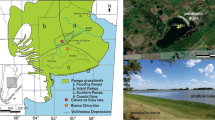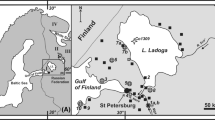Abstract
The Early and Middle Flandrian geological development and paleolimnology of Lake Spitaalijärvi was studied using pollen, diatom and cladoceran analysis and 14C dating. Spitaalijärvi was isolated from the Ancylus Lake about 9000 B.P., at which time birch and pine and plants typical of open habitat communities grew on the solitary island. The rational limits for Alnus and Picea were ca. 8300 B.P. and 3700 B.P., respectively. During the first few hundred years after isolation Spitaalijärvi was probably fairly eutrophic, with a low water level. Water level began to rise before the Alnus rise (A°) and the lake became oligotrophic. After another transgression, which started before the Picea rise (P°), Tabellaria binalis and Semiorbis hemicyclus appear in the diatom stratigraphy indicating ultra-oligotrophic conditions.
The main reason for the ultra-oligotrophy of Lake Spitaalijärvi is the character of the parent material in the catchment, consisting of glacial and littoral deposits derived from the local quartz sandstone of highly siliceous nature.
Similar content being viewed by others
References
Alhonen, P., 1967. Paleolimnological investigations of three inland lakes in south-western Finland. Acta bot. fenn. 76: 1–59.
Alhonen, P., 1970a. The paleolimnology of four lakes in southwestern Finland. Ann. Acad. Sci. fenn. A 3: 1–39.
Alhonen, P., 1970b. On the significance of the planktonic/littoral ratio in the cladoceran stratigraphy of lake sediments. Comment. Biol. 35: 1–9.
Berglund, B. E. (Ed.), 1979. Paleohydrological changes in the temperate zone in the last 15 000 years. 1GCP 158 B. Lake and mire environments. Project guide, vol. 2. Specific methods. Lund., 340 pp.
Donner, J. J., 1971. Towards a stratigraphy division of the Finnish Quaternary. Comment. Phys-Math. 41: 281–305.
Donner, J. J., 1972. Pollen frequencies in the Flandrian sediments of Lake Vakojarvi, south Finland. Comment. Biol. 53: 1–19.
Hyvärinen, H., 1976. Flandrian pollen deposition rates and tree line history in northern Fennoscandia. Boreas 5: 163–175.
Hyvärinen, H. & Alhonen, P., 1970. The sediment history of a 100 year old pond near lake Höytiäinen, eastern Finland. Geol. Fören. Stockholm Förh. 92: 410–414.
Lehman, J. T., 1975. Reconstructing the rate of accumulation of lake sediment. The effect of sediment focusing. Quat. Res. 5: 541–550.
Quennerstedt, N., 1949. Om diatomeerna Actinella punctata Lewis och Tabellaria binalis (Ehr.) Grun. i svenska vatten. Svensk bot. Tidsk. 43: 82–97.
Salomaa, R., 1982. Erikoinen Lauhanvuori. (summary: Geological development of Lauhanvuori). Suomen Luonto 1: 30–33.
Simonen, A. & Kouvo, O., 1955. Sandstones in Finland. Bull. Comm. geol. Finlande. 168: 57 87.
Author information
Authors and Affiliations
Rights and permissions
About this article
Cite this article
Salomaa, R., Alhonen, P. Biostratigraphy of Lake Spitaalijärvi: an ultraoligotrophic small lake in Lauhanvuori, western Finland. Hydrobiologia 103, 295–301 (1983). https://doi.org/10.1007/BF00028469
Issue Date:
DOI: https://doi.org/10.1007/BF00028469




